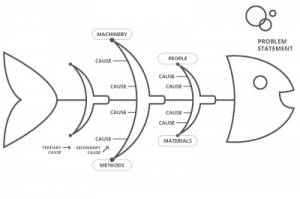


As in the above image, these are equipment, process, process, people, material, environment, management, maintenance, Supplier, Safety, Price and the list can go on. Step5: Brainstorm the major categories that might act as a cause to the problem. Step4: Create branches of categories to the horizontal running arrow. Step3: Draw a running arrow horizontally to the problem running towards the problems. Step 2: Write the problem statement/effect onto the right side of the diagram. Step 1: Bring your project team together into one meeting, including all stakeholders connected to the problem will make the analysis effective. Steps to perform an Ishikawa diagram keeping the above template as a reference Identifying and categorising the variables that contribute to the causes with the key relationship to the problem. The principle is that there might be many causes for a problem or effect to happen. Referring to the below picture, the diagram consists of a fish head - encircled as the “problem” or the “effect’ that the user experiences. Now as we understood why to use a fishbone diagram let us see what constitutes a fishbone diagram: Kaoru Ishikawa who was known for his contributions in quality and chemical engineering. This is considered as one of the 7 basic tools of quality generated by Mr. The latter can be used when a more detailed analysis is required for a specific problem.įishbone diagrams are known by different names - Ishikawa diagram, Herringbone diagram, Cause and effect diagram. In this article we will be understanding another tool to perform root cause analysis, understanding the cause and effect relationship that leads to your problem and why such a problem has occurred.īefore we understand deep about fishbone diagrams, it is important to know the difference between 5 Why and Fishbone - The former is used as a practical questions technique depending on how effective the questions are asked to reach the root of the problem. Two weeks back we had understood about 5 Why problem-solving, if you have missed the article please refer to the link in the comment box.


 0 kommentar(er)
0 kommentar(er)
